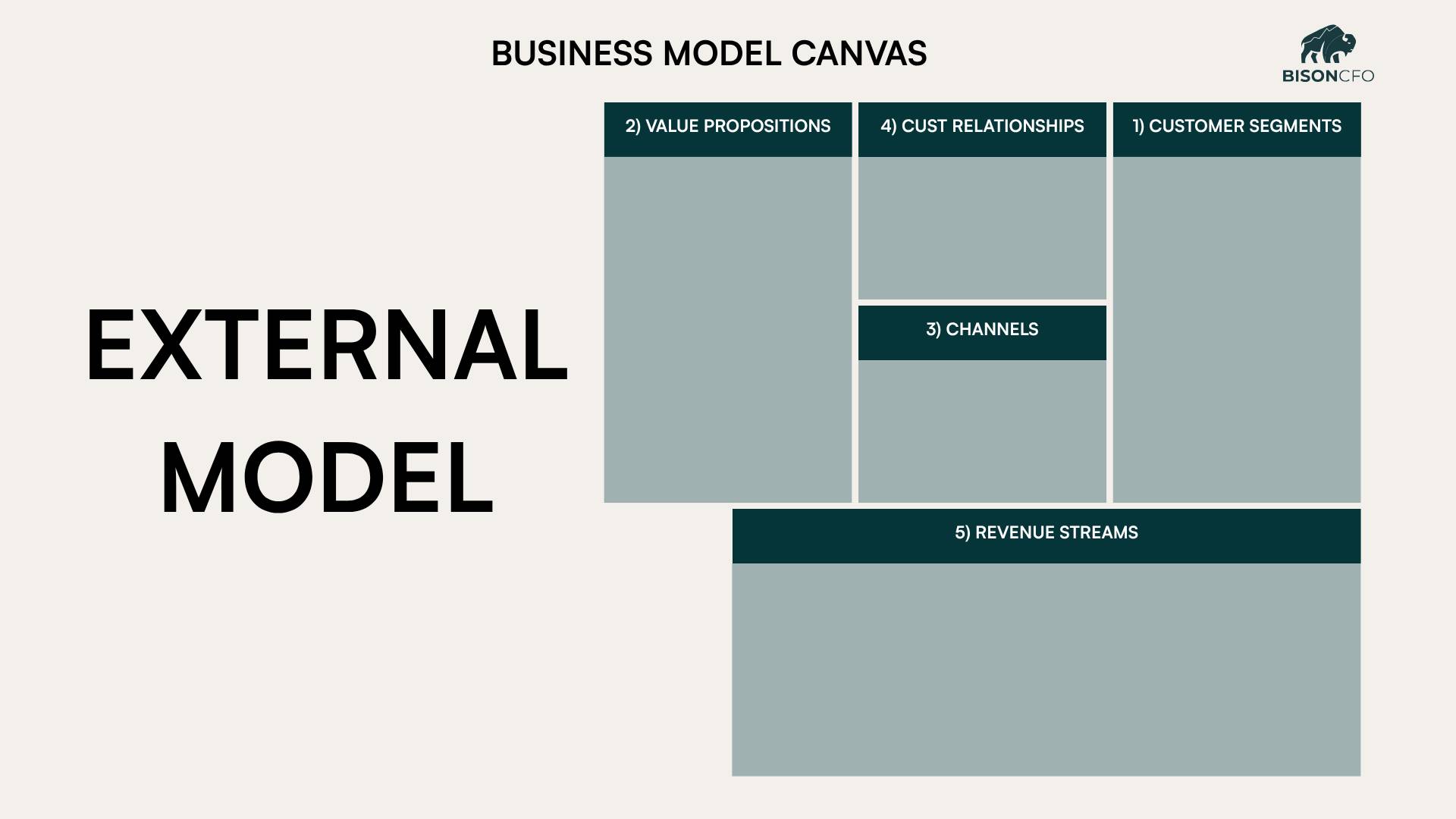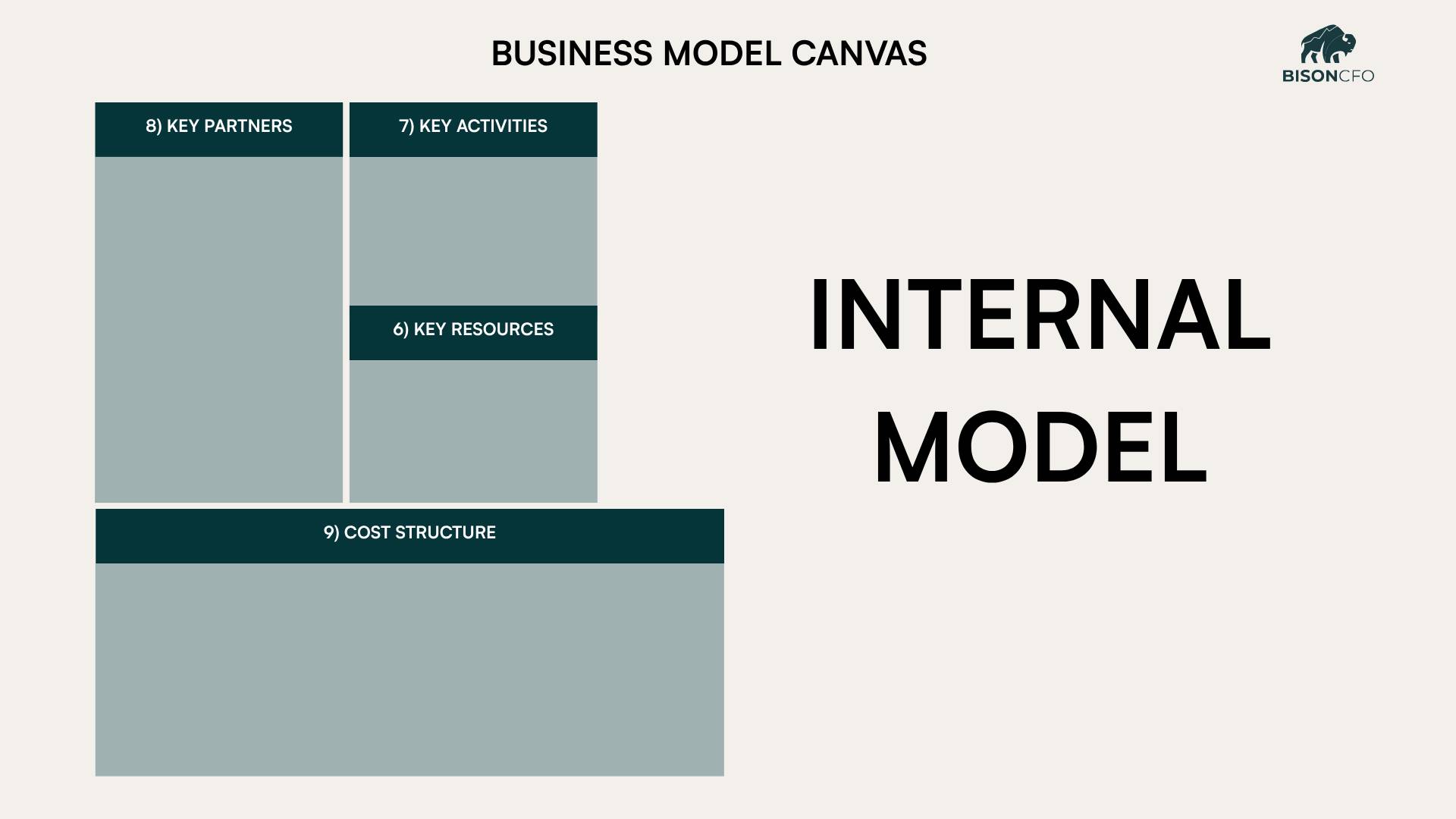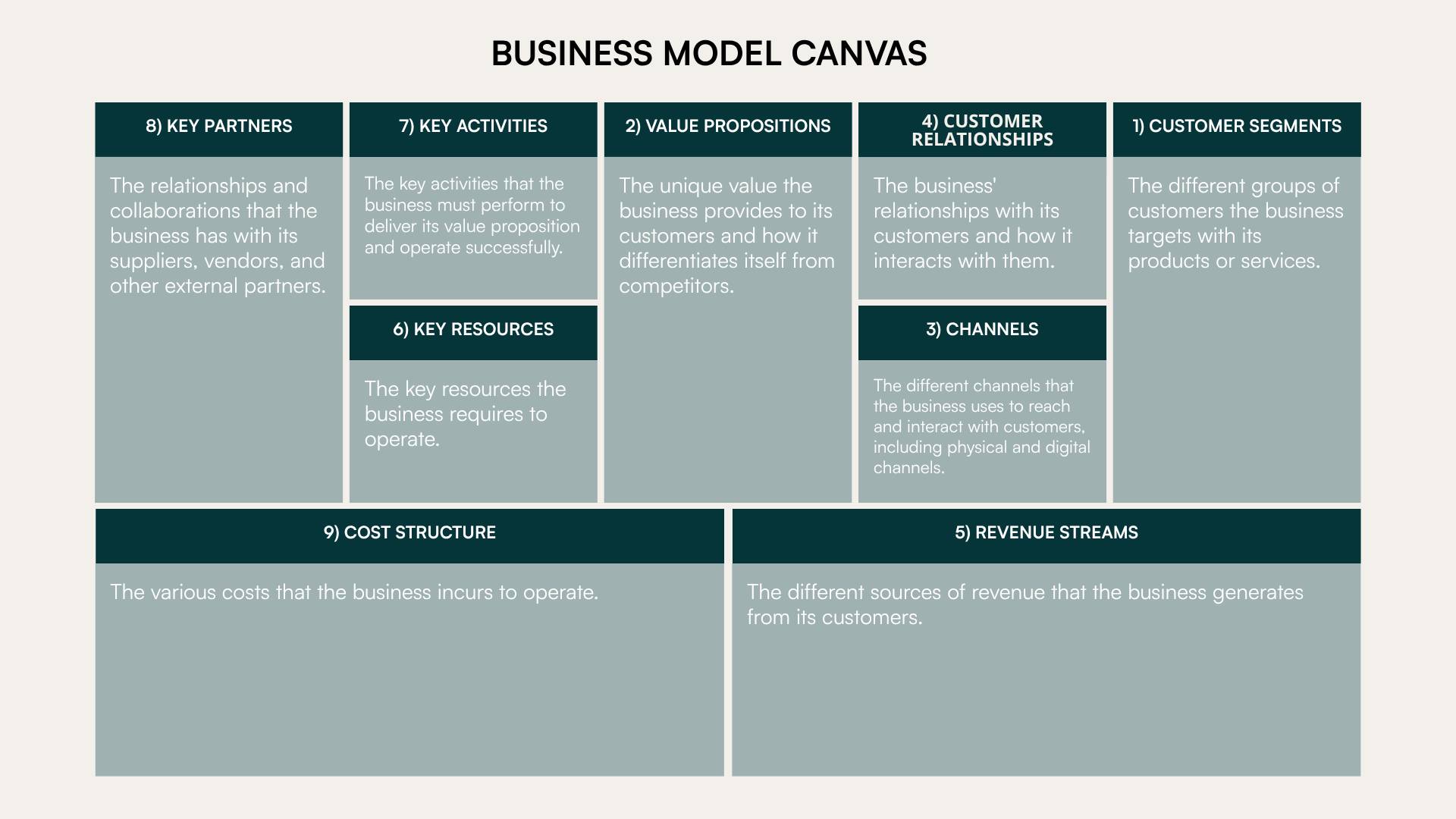Most people think a CFO shows up with spreadsheets, ratios, and financial models.
But when a new client hires us at Bison CFO, the first thing we pull out isn’t a spreadsheet… it’s a single sheet of paper: The Business Model Canvas.
At first, this throws people off. “Aren’t you supposed to be doing the numbers? Why are we talking about customers and value props?”
Because here’s the truth: Your financials are just the downstream effect of how your business actually works. If we don’t understand the business, we can’t advise it.
And for most small and mid-sized businesses, almost no one has ever mapped out how the business really functions.
The Business Model Canvas gives you a shared language, exposes assumptions, and ultimately creates clarity about what the business does and how they do it.

We use it with every client because it accelerates understanding for us, but we also consistently see something “clicks” for the leadership teams we do this with.
Below, we’ll walk through all nine sections of the canvas, using a physical security business as our example.
EXTERNAL MODEL

The first thing we always tackle are the external elements of the business model. We call these the market-facing elements:
- Customer Segments: Who you’re serving. Distinct groups with distinct needs.
- Value Propositions: Why they choose you. The promise you deliver.
- Channels: How you reach them. Sales, marketing, distribution.
- Customer Relationships: How you interact with them. High-touch, low-touch, tech-enabled, or personal.
- Revenue Streams: How money comes in. Pricing, billing, models, monetization.
The order of these elements is important, as the external elements are all interrelated.
Let’s walk through them.
1. CUSTOMER SEGMENTS
Who Are You Actually Serving?
Everything hinges on this. Customer segments are the groups of people or organizations you sell to.
Most businesses start with one customer profile but expand over time. That’s where things get muddy. Two customers may look similar from the outside (e.g., two commercial properties), yet need very different things.
For a physical security company, potential segments might include:
- Commercial properties
- Residential communities
- Event security
- Healthcare
- Government contracts
- Specialty industries (museums, industrial, etc.)
We might start this differentiation by just looking at how you track and understand your business. Next, we then go to asking the question: Are there any segments here that we should separate because there are different needs associated with those segments ?
The forcing function here is powerful: What groups genuinely have different jobs, pains, or needs?
If the needs differ, the business model will differ.
We always tell clients: Don’t get dogmatic. This isn’t about listing every customer you’ve ever served. It’s about identifying the meaningfully distinct groups that drive decisions in your business.
2. VALUE PROPOSITION
Why Do They Buy You?
Once you know who you’re serving, the next question is: Why would they choose you instead of someone else?
A value proposition is not a list of services you offer. It’s the unique combination of benefits that solves a specific pain for a specific customer.
Examples in a security business might be:
- 24/7 rapid response
- Law-enforcement-trained personnel
- Deep expertise in a specific industry
- Custom site planning
- Advanced tech integrations
- Higher reliability or lower turnover
- A more flexible contract model
Value props are where we see the biggest breakthroughs because many owners think they know their value prop until we ask, “How is that unique?” Then they realize it isn’t.
A real value prop is what you’d confidently lead with in a competitive bid.
3. CHANNELS
How Do You Reach Your Customers?
Your channels are simply how you communicate and deliver your value prop to the people you serve. This connects your value prop to the customer segment.
Look at each segment and ask: what is the value prop for this segment and how do we connect this customer segment to the value prop we bring them?
Different segments often require entirely different channels.
For our security example:
- B2B property managers → relationships, networking, direct sales
- Government entities → RFP/bidding processes
- Individual consumers → digital marketing, apps, on-demand platforms
4. CUSTOMER RELATIONSHIPS
How Do Customers Expect You to Interact With Them?
This part gets overlooked, but it’s incredibly important.
Customer relationships answer: What does ongoing interaction look like? What does the customer expect?
In security, this could be:
- Dedicated account manager
- Supervisor onsite
- A staffed call center
- A purely self-service portal
- Direct interaction with guards or onsite staff
Different segments expect different levels of touch.
And the level of touch has cost implications. Pricing and relationships go hand-in-hand.
A mismatch here is deadly:
- High-touch customer + low-touch support = churn
- Low-touch customer + high-touch support = margin drain
We want alignment, not surprises.
5. REVENUE STREAMS
How Does Money Actually Come In?
Every business has multiple revenue streams… often more than the owner realizes.
We want to make sure we understand how each customer segment and value proposition is converting into revenue dollars.
In a security company:
- Hourly guard services (armed/unarmed)
- Recurring contracts
- Event-based work
- Consulting, assessments, or policy development
- Tech installation or monitoring
- Retainer-based services
INTERNAL MODEL

Once we understand the external model, we can turn to the internal model and the things that allow us to deliver on the external model.
These are the “operational backbone”:
- Key Resources: The assets required—people, tech, capital, equipment, IP, relationships.
- Key Activities: The essential processes you must execute consistently to deliver value.
- Key Partners: The external dependencies that extend or support your capabilities.
- Cost Structure: The cost drivers of the business model — fixed, variable, people, assets, partners, complexity.
They define your capacity to deliver what the external model promises.
This is where execution happens. If your internal model doesn’t match the external model, growth becomes painful or impossible.
These ensure you can deliver the Value Proposition using the Channels and Relationships you’ve defined.
This system answers: “Can we actually do what we say we can do, at scale?”
6. KEY RESOURCES
What Must Exist for the Business to Function?
Key resources are the assets (physical, human, or intellectual) your business requires.
For security:
- Personnel
- Scheduling software
- Vehicles (if roving)
- Insurance & licensing
- Tech infrastructure
This section seems simple, but it’s where founders routinely underestimate risk.
If a single key resource fails, such as training or scheduling, your whole operation can crumble. Mapping these resources makes those weak spots visible.
7. KEY ACTIVITIES
What Are the Critical Things You Must Do Well?
These are the essential activities that deliver your value prop.
In security, that might include:
- Recruiting and onboarding
- Guard training
- Dispatch/scheduling
- Supervising staff
- Bidding and estimating
- Payroll (mission critical in guard services)
This is where operational bottlenecks become obvious.
If you can’t consistently execute your key activities, your value prop collapses… no matter how good it looks on paper.
8. KEY PARTNERS
Who Do You Rely On?
Every business has external partners that make the machine run.
For security companies:
- Training providers
- Law enforcement recruiting pools
- Software vendors
- Insurance carriers
- Tech integrators
- Payroll providers
Good partners can go bad, because of growth or change on their end, and not having a plan for that can wreck an otherwise good business.
Mapping these relationships reveals which ones carry the most risk and which ones need upgrading before growth.
9. COST STRUCTURE
What Are the Big Costs That Drive the Business?
This is simple but essential. Look at your P&L. What shows up big?
In security:
- Labor
- Overtime
- Benefits
- Training
- Uniforms/equipment
- Vehicles
- Marketing
- Insurance
But the nuance is here: Which costs are fixed, which are variable, and which can blow up without warning?
Overtime, for example, can kill a profitable contract overnight if unmanaged.
Understanding your cost structures and revenue = profitability.
PUTTING IT ALL TOGETHER

It’s easy to look at your business from day-to-day and think that you have a bunch of independent parts, but when you look at the business model canvas as a whole, you can start to see the interconnectivity of each of those parts.
When customer segments align with value prop… and value prop aligns with channels… and channels align with relationships… and activities/resources/partners support everything… The business becomes easier.
Growth feels more natural.
And the founder stops feeling like every step is uphill.
But when even one piece is misaligned?
Everything becomes harder than it should be.
So remember:
If you change your customer segment, your value prop changes. If your value prop changes, your activities and resources change. If your activities/resources change, your cost structure changes. And the pricing/revenue model must adapt accordingly.
This is also true for introducing new things in a business. Want to serve a new customer segment? Ask: what does this change about our channels and customer relationships?
If you’re having to “launch” new channels, relationships, and add to your value prop, it might not be the right customer segment for you.
You can also look at this on it’s own and ask: what current external capacity that we have could we leverage even more? If you’re good at outreach, which segments are primed for response to outreach?
So, if someone says, “We should start selling into government,” we can immediately evaluate:
- Does your current value prop fit?
- Do you have the right channel?
- Are you ready for the infrastructure shift (bidding, compliance, documentation)?
Often the answer is: not yet. This answer alone saves people from very expensive detours.
LET US HELP YOU
Most SMBs never slow down long enough to map how their business actually works. And doing so can lead to a business that seems hard instead of easy.
So let us help you: we do this with every business we sit down with and we’ve yet to encounter someone who wasn’t transformed by the process.
We’ll walk you through and help you map both current and future state of the business.
Just reply to this email and we can set up a time meet.


